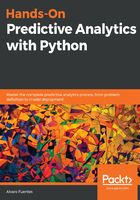
Anaconda
Here's the description of Anaconda from the official site:
The analogy that I like to make is that Anaconda is like a toolbox: a ready-to-use collection of related tools for doing analytics and scientific computing with Python. You can certainly go ahead and get the individual tools one by one, but it is definitely more convenient to get the whole toolbox rather than getting them individually. Anaconda also takes care of package dependencies and other potential conflicts and pains of installing Python packages individually. Installing the main libraries (and dependencies) for predictive analytics will probably end up causing conflicts that are painful to deal with. It's difficult to keep packages from interacting with each other, and more difficult to keep them all updated. Anaconda makes getting and maintaining all these packages quick and easy.
It is not required, but I strongly recommend using Anaconda with this book, otherwise you will need to install all the libraries we will be using individually. The installation process of Anaconda is as easy as installing any other software on your computer, so if you don’t have it already please go to https://www.anaconda.com/download/ and look for the downloader for your operating system. Please use Python version 3.6, which is the latest version at the time of writing. Although many companies and systems are still using Python 2.7, the community has been making a great effort to transition to Python 3, so let's move forward with them.
One last thing about Anaconda—if you want to learn more about it, please refer to the documentation at https://docs.anaconda.com/anaconda/.